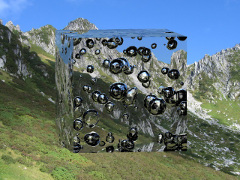Jan. 8, 2015
How the physics of champagne bubbles could lead to better turbines
 Image by H. Watanabe, ISSP, the University of Tokyo and H.Inaoka, RIKEN AICS
Image by H. Watanabe, ISSP, the University of Tokyo and H.Inaoka, RIKEN AICS
In research published in the Journal of Chemical Physics, researchers from the University of Tokyo, RIKEN, and Kyushu University have used RIKEN’s K computer to better understand how bubbles develop in liquids—as in champagne, where tiny bubbles at the bottom of the glass gradually grow to larger ones as they rise through the liquid, in a process known as Ostwald ripening.
Although champagne bubbles are a good example of how we see the phenomenon in daily life, in fact this process is an important factor in the efficiency of turbines in power plants and propellers on ships, as well as in the creation of metal alloys, where bubbles can affect the strength of the material.
The team performed massively parallel simulations with 4,000 nodes of the K computer to model an incredible 700 million particles through a million iterations. The huge simulations enabled them to make detailed comparisons of the actual behavior of bubbles with the predictions of classical theory, and the team found that classical theory offers a good description of the formation of bubbles. The insight they obtained is a fundamental finding, which cannot be put into application in the real world right away. The team, however, is now moving toward the next step—performing more realistic simulations of bubbles at the molecular level. The research may eventually help us to design more efficient devices.
For more detailed information, see the journal’s press release.
